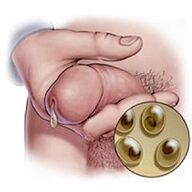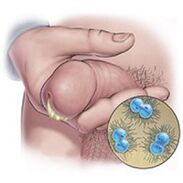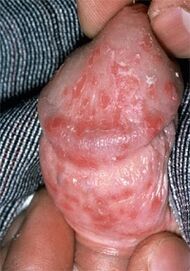
Genital discharge in men is a discharge from the urethra (urethra) and glans gland, located on the tip of the penis, under the foreskin. The ejaculatory duct, prostate gland, urethral gland, and anal canal open into the urethra.
In a healthy man, only urine and ejaculation flow through the urethra. This is a physiological discharge from the penis and does not cause discomfort. Unfortunately, this is not always the case.
For various reasons, men's health is shaken and instead of normal discharge, abnormal discharge or urine and semen changes appear.
Variations of physiological secretions
Criteria for normal discharge correspond to the function of the organs of the genitourinary system:
- Urine - clear, from straw yellow to yellow, practically odorless, without scales or other impurities;
- Prostate secretions are viscous and slightly white, with a characteristic odor of sperm;
- Ejaculation: sperm from the ejaculatory duct mixes with secretions from the Littre (urethra) glands, Cooper (ureter) and prostate secretions, creating a gray-white and thick consistency;
- Fresh slime from the anterior glands resembles a thick layer of white fat; may turn yellowish or bluish over time.
The pre-foreskin lubricant - smegma - is secreted continuously, accumulating under the inner layer of the foreskin and in the foreskin groove of the penis. The lubricant consists of fat and bacterial residue, which is evenly distributed and reduces friction between the foreskin and foreskin. The maximum activity of the vestibular glands is inherent in puberty, with age, secretion gradually decreases and stops completely with old age.
If you ignore the rules of personal hygiene, then smegma can accumulate under the folds of the foreskin. In this case, the fatty part of the lubricant oxidizes, and the protein part decomposes (it is in fact rotting), and the masses become green, with an unpleasant odor. The same process occurs with foreskin stenosis, when, due to the fusion of the foreskin, it is not possible to completely release the head of the penis from the skin folds and remove the foreskin. The buildup and breakdown of lubricant can lead to chronic balanitis and balanitis (inflammation of the foreskin and glans penis), increasing the risk of developing tumors.
Urinary, mucoid, colorless discharge from the urethral canal and urethral glands. Discharge data appear in aroused men in relation to sexual desire. The secretion of clear mucus is intended to lubricate the urethra and improve the circulation of semen. The amount of secretion ranges from small to abundant, these parameters are associated with the individual characteristics of the organism and the frequency of sexual activity. After a prolonged period of abstinence, the amount of secretions increases.
Contamination is the spontaneous release of spermatozoa, unrelated to intercourse. Usually seen in the morning when testosterone levels are high. Depends on age and intensity of sexual activity: it occurs in boys during puberty, in adult men - with infrequent or rare intercourse.
Prostate hypersecretion, secreting from the urethra a small amount of clear, grayish-white mucus. It occurs after straining the abdominal muscles (for example, when constipated) or after urinating. A discharge consisting of a mixture of semen and prostate secretions, and an increase in volume and opacity can be signs of prostatitis.
Discharge from hospital
In men, the cause of discharge from the penis can be STDs, tumors, nonspecific inflammation of the genital organs, trauma, medical manipulation, or surgery.
Pathological discharge from the urethra that is different from normal:
- By volume (too abundant or scarce, maybe just right);
- About color and transparency (from white to yellow-green, cloudy);
- Due to impurities (blood, pus, clotted mucus);
- Consistency (very thin or too thick and sticky);
- By smell (sour, sour, fishy);
- According to the frequency of occurrence (depending on the time of day, continuous or intermittent discharge);
- Involves urinating, aphrodisiacs, drinking alcohol, and spicy and spicy foods.
The nature of the discharge depends on the causative agent, the state of the immune system, comorbidities, as well as the severity and duration of the inflammation (acute or chronic).
If the amount, density, or color of the discharge changes, or if there is an unpleasant odor, you should see a doctor and get tested. Self-diagnosis is not worth it, it is difficult to accurately identify the disease through just one symptom.
Penile discharge associated with STDs

Mucus: clear, viscous and small amount of discharge, found in the chronic form of urethritis caused by chlamydia, mycoplasma or ureaplasma. Microscopy revealed a moderate number of leukocytes in the exudate (standard is a maximum of 4 cells per field of view).
Mucus: white, translucent discharge; observed during exacerbations with chlamydia, ureaplasmosis and mycoplasmosis. In the case of chlamydia, they accumulate on the tip of the penis, as if "sticking" to the skin.
With the pathologies described above, discharge will come from the urethra itself, as microorganisms irritate the mucous membrane of the urethra, and the body tries to "wash it off".
It happens that the secret of white seems to cover the head. This is noted with chlamydia, candidiasis. In the first case, a film is formed, in the second - a cheesy bloom.

A pus discharge with an unpleasant odor is a sign of gonorrhea. They are sticky, dense, yellow or green in color, and have a rotten smell. Microscopy showed epithelial cells from the urethra, many leukocytes.
Symptoms accompanying urethritis caused by urethritis: persistent and abundant discharge; Especially pain, itching and burning when urinating.
In sexually transmitted diseases, combined infections are often observed, combining several pathogens at once. Gonorrhea and trichomoniasis associated with chlamydia, mycoplasmosis and ureaplasmosis are often found in pairs. The symptoms of such diseases differ from the classic manifestations; Urethral discharge can also have an entirely different character. Therefore, for the final diagnosis, modern analytical techniques are used with a high degree of confidence, not the discharge characteristics.
Non-specific (non venereal) inflammation
The cause of nonspecific inflammation is a conditionally pathogenic microflora and is activated only in the event of a problem with the body's immune defenses. Streptococci and staphylococci, fungi of the genera Candida and E. coli are always present on the surface of the skin and mucous membranes, but they begin to actively multiply and take the place of beneficial bacteria after hypothermia, prolonged stress, uncontrolled antibiotic therapy, after courses of radiation therapy. and chemotherapy.
Nonspecific (nonspecific) urethritis. Inflammatory fluid is small in quantity, visible in the urine as pus-filled threads or lumps, appearing in the early stages of the disease. Symptoms such as burning and itching when urinating are less obvious than with gonorrhea, but urinating is frequent and does not improve. With progressive infection, first the bladder becomes inflamed, then the ureters and kidneys; exudate with a mixture of bright red blood appears.

Candida infection (thrush), urethral yeast infection. Usually develops against the background of suppression of the immune system after a course of antibiotics, chemotherapy or radiation therapy; Sexual transmission of candidiasis in men is rare. Thrush is characterized by a thick, sour-smelling discharge, associated with itching and burning during urination (urination) and ejaculation (ejaculation), and may be accompanied by a dull ache in the groin or pubic area. and in the lower back.
Urinary tract infection. The fishy smell of the typical rinse water; they have small, yellowish or bluish white scales. By some classifications, Gardnerellosis is referred to as an STD, but in men, a sexually transmitted infection with Gardnerella is more likely to be out of curiosity. In fact, this disease is associated with a violation of the normal microflora, that is, with dysbiosis. In its treatment, immunomodulators and probiotics (lactic acid bacteria) are necessarily used.
Balanoposthitis, inflammation of the foreskin. Locally observed profuse purulent discharge, possibly with a mucinous mixture. Always accompanied by edema and congestion (redness) of the glans, penile headache.
With prostatitis, cloudy discharge appears when urinating, abundant discharge - in the acute inflammatory phase; thin and white - with the transition of the disease into a chronic form. Prostatitis is often complicated by difficulty urinating and weak erection, in severe cases - possible anuria (complete absence of urine flow) and impotence.
Discharge not related to inflammation

Increased spermatogenesis - secretion in the form of passive flowing sperm, occurring outside of sex or masturbation, with no sensation of orgasm. It is caused by certain diseases of the nervous system, spinal cord injury, chronic stress and any prolonged inflammation in the genital area. Increased spermatogenesis is associated with a violation of the endocrine system and a decrease in the sound of the vas deferens.
Increased blood secretion, spotty. Often appears with injuries of the urethral canal received during cleaning, after placing a catheter or when removing a smear from the mucous membrane. In these cases, the blood is fresh, there is no clot, the amount is small, and the bleeding is stopped quickly. When small stones or sand pass, blood is passed out during or shortly after urinating, bloody stools accompanied by very severe pain (renal colic). Hematuria in the form of a hematoma of glomerulonephritis (glomerulonephritis) associated with edema and persistent high blood pressure, the presence of protein in the urine.
A brown, clotted, or mucoid discharge with pus is present in malignancies arising from the prostate, urethra, or bladder. Brown mucus can form during wound healing on mucous membranes and is secreted with polyps in the urethra and/or bladder.
Prostatic hypersecretion is the secretion of prostate gland that drains from the urethra. It occurs in chronic prostatitis, prostate neoplasms, endocrine insufficiency (neurogenic bladder).
Algorithm that checks for the presence of pathological secretions from the penis

- Examine the perineum, penis, foreskin, and foreskin. The aim is to identify malformations of the genital organs, their traces of trauma, external signs of inflammation, discharge, rash, etc. The traces of discharge are sometimes conspicuous on the fabric.
- Feel the inguinal nodes, assess their condition: size, warmer or colder than surrounding tissues, pain or not, tenderness or thickening, mobility or adhesion to the skin, whether there are sores on them.
- Finger prostate examination; Massage the prostate gland through the rectum and collect the secretions for microscopic examination. Before massaging, you should hold your urine for 1-2 hours. In the case of a prostate tumor, its lobes are approximately equal in size, dense fibers can be palpable. For a malignant tumor, their uneven growth and consistency are typical; When palpating the prostate gland, clotted blood may leak from the urethra.
- Materials - smears for microscopy and culture. When examined under a microscope, a stained smear reveals blood cells, epithelium, spermatozoa, fatty impurities, certain pathogens (Escherichia coli, gonococci, gardnerella, yeast). Increased white blood cell count is characteristic of acute urethritis or exacerbation of chronic inflammation, eosinophilia - for allergic urethritis. Sex cells are found in severe infections, tumors, damage to the genital organs, and urinary stones. Frequent urination is a sign of chronic urethritis, urethral leukoplakia. With an increase in spermatogenesis, sperm cells are found in a smear, with an increase in urinary - mucus, with an increase in prostate secretion - lipid granules. For informative content and reliability of results, smears were performed no earlier than 3 days after topical antibiotic, antifungal and antiseptic application. If systemic antibiotic treatment, then at least 3 weeks after the course. Before taking the unwashed topical, try not to urinate for 2-3 hours.
- General clinical analysis of blood, blood sugar levels - in the morning, on an empty stomach. Extend urinalysis (morning, immediately after sleep).
- Ultrasound of the prostate, bladder and kidneys; CT and urinary computed tomography.
If the symptoms of infection of the genital organs are strong, before the test results are available, the patient will be prescribed antibiotics with broad effect immediately. When bleeding is profuse, hospitalization and aggressive measures should be taken to stop the bleeding. Confirmation of suspected malignancy can only be the result of biopsy, the final diagnosis is made on the basis of histological examination.
Important:
- Penile discharge is only a symptom that cannot be guided in diagnosis.
- The independent appointment of the farm is unacceptable. medication, even if the symptoms seem obvious to a particular disease.

























